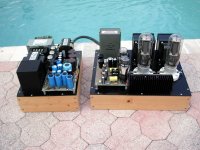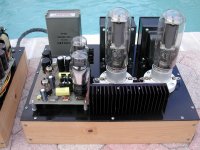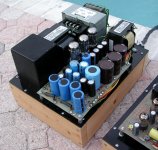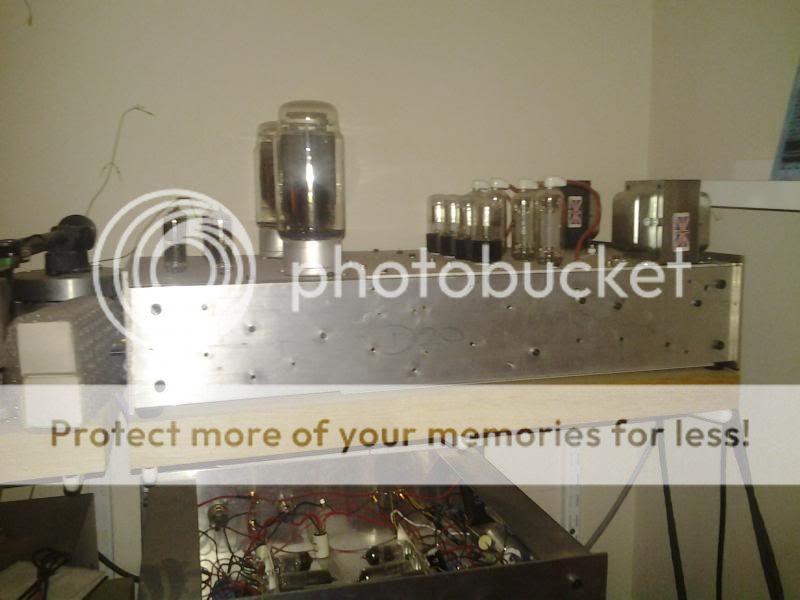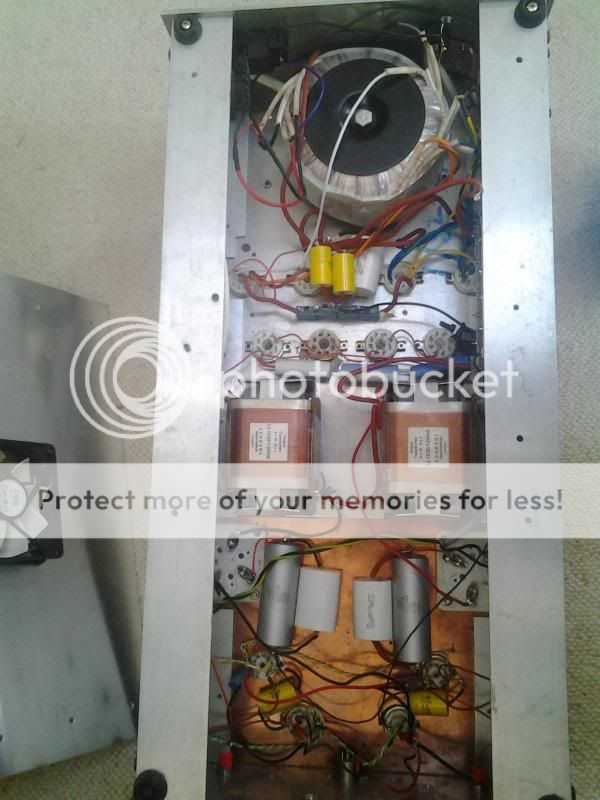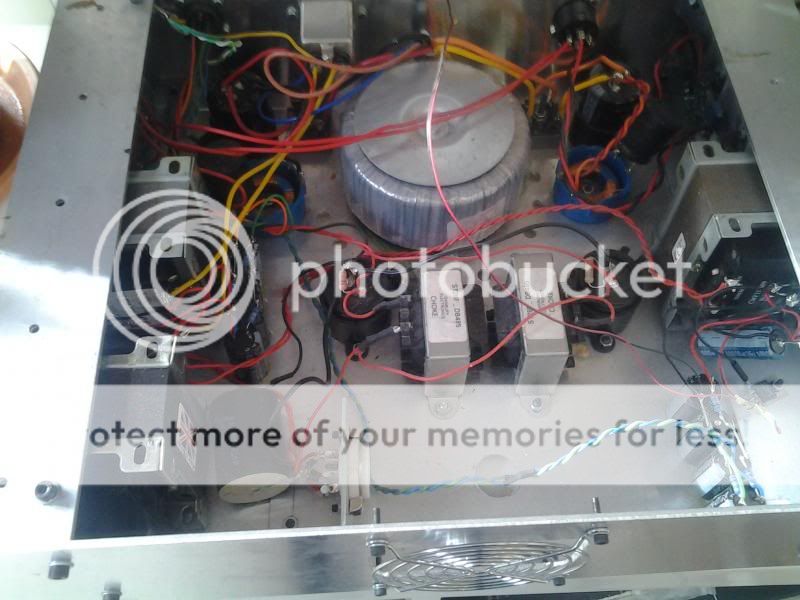I am planning on building an 845 amp. I was considering a power supply just for the 845 and a separate PS for the input driver stage. The 845 will be IT coupled to the driver.
I was wondering what the feasibility is of building the 845 and power supply in its own chassis and the input/driver with its own supply in another chassis. I was thinking of lockable din plugs and sockets. (I would think no more than 1/2m of interconnect.) Would there be any issues of the IT being that far? Or any other issues.
I've been thinking about it because I thought it would be an easy way in the future for experimentation. For example, I can change the 845 OPs or try another configuration with the driver without having to go through all the circuit. (I can't play an unsecured breadboard as I have a kid around.). Thanks.
I was wondering what the feasibility is of building the 845 and power supply in its own chassis and the input/driver with its own supply in another chassis. I was thinking of lockable din plugs and sockets. (I would think no more than 1/2m of interconnect.) Would there be any issues of the IT being that far? Or any other issues.
I've been thinking about it because I thought it would be an easy way in the future for experimentation. For example, I can change the 845 OPs or try another configuration with the driver without having to go through all the circuit. (I can't play an unsecured breadboard as I have a kid around.). Thanks.
What voltage do you plan on running the 845 at? I believe 650v is minimum. And what are you going to use for a driver tube? I ask because going with IT design you need to have a really good transformer (silver wire would be nice) and they can get expensive. Direct coupling usually beats out a cap and transformer any day so if you have some voltage to play with you could elevate the cathode of the 845 to say 168 volts and using a 6SN7 for example with 100 plate volts directly coupled to the 845 will give you a bias of -68v as per data sheet for a plate voltage of 650v. So add 168 to 650 you get 818 this is what your B+ should be.
Somebody else smarter than me will probably chime in soon.
Somebody else smarter than me will probably chime in soon.
Actually, for the start of this experiment, I'm looking only at starting at relatively low voltage for the 845. The B+ will be circa 550-600v as its easier to get hold of 630v rated caps. (I'm holding back getting in to voltage doubling, series caps and high voltage. This will be my first build that will go past 500v.)
I'll only be playing with Hammond Transformers throughout, nothing exotic. This is a work/experiment in progress but due to limitations in space and having a kid around, I have to have it chassied for safety. This was why it came to mind to split and make modular the stages of the amp, for future ease at tweaking.
The driver planned is a 45/2a3 IT coupled to the 845. The input, so far, is planned to be a 102d RC to the driver (I'm still looking at that, if not then an octal.) The project will be more a learning tool rather than an attempt at an outstanding amp.
I'll only be playing with Hammond Transformers throughout, nothing exotic. This is a work/experiment in progress but due to limitations in space and having a kid around, I have to have it chassied for safety. This was why it came to mind to split and make modular the stages of the amp, for future ease at tweaking.
The driver planned is a 45/2a3 IT coupled to the 845. The input, so far, is planned to be a 102d RC to the driver (I'm still looking at that, if not then an octal.) The project will be more a learning tool rather than an attempt at an outstanding amp.
Do not even think about 845 tube if you cannot get 1000V or more at plate. IT is only really needed if you want to use it in A2 mode with significant grid current (and thus get more than 13-15W from it).
Did you think about "power drive" circuit with directly coupled MOSFET source follower as driver?
I still suggest single chassis to keep setup simple.
Did you think about "power drive" circuit with directly coupled MOSFET source follower as driver?
I still suggest single chassis to keep setup simple.
I'm working towards 1kv for the 845 but after getting a bit more confidence and experience. Also, the idea of trying out different driver circuits and configurations will be part of the process. These really are the considerations for dual chassis and each stage having its own power supply. For example, I can work on raising the working voltages on the output stage without worrying about the effects on the preceding stages or I can swap driver circuits and make a/b comparisons quickly. In the end, when I feel I've hit 'my sound', then it will be made single chassis or monoblocks. So I'm planning, if its feasible.
The reason I went for 845s to experiment with is because I figure they'll withstand the abuse of experiments and I have a lot of headroom to play with voltage wise. I also got them cheap. The 45/2a3 choice was simply because that's what I have lying around and I've seen them as driver valves. I have plenty of 6s*7 to play with but pulled the trigger on a pair of 102d (impulse buy really...) now I'm seeing if I can use them.
My rating is beginner and although I've assembled SE amps and tweaked them before, this is the first time I'm diverging from a known schematic. Hence my idea of it as a secured breadboard rather than a final amp.
The reason I went for 845s to experiment with is because I figure they'll withstand the abuse of experiments and I have a lot of headroom to play with voltage wise. I also got them cheap. The 45/2a3 choice was simply because that's what I have lying around and I've seen them as driver valves. I have plenty of 6s*7 to play with but pulled the trigger on a pair of 102d (impulse buy really...) now I'm seeing if I can use them.
My rating is beginner and although I've assembled SE amps and tweaked them before, this is the first time I'm diverging from a known schematic. Hence my idea of it as a secured breadboard rather than a final amp.
I'm working towards 1kv for the 845 but after getting a bit more confidence and experience. Also, the idea of trying out different driver circuits and configurations will be part of the process. These really are the considerations for dual chassis and each stage having its own power supply. For example, I can work on raising the working voltages on the output stage without worrying about the effects on the preceding stages or I can swap driver circuits and make a/b comparisons quickly. In the end, when I feel I've hit 'my sound', then it will be made single chassis or monoblocks. So I'm planning, if its feasible.
The reason I went for 845s to experiment with is because I figure they'll withstand the abuse of experiments and I have a lot of headroom to play with voltage wise. I also got them cheap. The 45/2a3 choice was simply because that's what I have lying around and I've seen them as driver valves. I have plenty of 6s*7 to play with but pulled the trigger on a pair of 102d (impulse buy really...) now I'm seeing if I can use them.
My rating is beginner and although I've assembled SE amps and tweaked them before, this is the first time I'm diverging from a known schematic. Hence my idea of it as a secured breadboard rather than a final amp.
For experiments you may buy one of Chinese 845 amps and then redo most of the circuit. At least you will have B+ supply for output stage, heater supply for the same and other pieces already there. Then you can play with driver stage. When working with over 500V you should be very careful not to kill yourself. Requirements to output transformer for 845 vary greatly depending on plate voltage. And this tube (like most transmitter tubes) sounds best, and have lowest distortion, when works at the limit - 1200V.
Last edited:
For experiments you may buy one of Chinese 845 amps and then redo most of the circuit. At least you will have B+ supply for output stage, heater supply for the same and other pieces already there. Then you can play with driver stage. When working with over 500V you should be very careful not to kill yourself. Requirements to output transformer for 845 vary greatly depending on plate voltage. And this tube (like most transmitter tubes) sounds best, and have lowest distortion, when works at the limit - 1200V.
Yes, I could've gotten a Chinese amp and re-done it (I did consider it). There is a criteria though for the challenge I set myself so this is the route I chose.
Thank you for your concern, I try not to kill myself working with any voltage
If I don't make progress, I can bash out a very reasonable 300b amp with the parts
On my gm70se amp i have the ht power supply and bias supply plus rod coleman regs and opt plus valves in the main chassis and filliment ps and driver ps in a seperate remote chassis. Works well and limits each box to <30kg! I also mount the tubes on a seperate plate so i can change driver setup or even the whole amp stage but retain ht ps and opt.
Enzo
Enzo
On my gm70se amp i have the ht power supply and bias supply plus rod coleman regs and opt plus valves in the main chassis and filliment ps and driver ps in a seperate remote chassis. Works well and limits each box to <30kg! I also mount the tubes on a seperate plate so i can change driver setup or even the whole amp stage but retain ht ps and opt.
Enzo
That sounds like a good idea. You wouldn't have pictures posted somewhere would you?
I didn't think to just separate the driver, filament PS and keep the rest in a main chassis with separate plates.
I put the power supply on one chassis, and the power amp on another. There is a 1 meter cable connecting them with Cinch Jones connectors.
The system is interlocked so that the power supply will not turn on without the amp attached. B+ is 1050 volts and the amp runs A2 for 40 WPC.
This amp was built over 10 years ago and still works great, but sees little use due to the heat that it puts out. It might see more use once I move north.
Yes there are deadly things in touchable places on both chassis. It will get rebuilt someday now that my wood working skills have improved beyond the "plywood and sheetrock screws" quality seen here.
The system is interlocked so that the power supply will not turn on without the amp attached. B+ is 1050 volts and the amp runs A2 for 40 WPC.
This amp was built over 10 years ago and still works great, but sees little use due to the heat that it puts out. It might see more use once I move north.
Yes there are deadly things in touchable places on both chassis. It will get rebuilt someday now that my wood working skills have improved beyond the "plywood and sheetrock screws" quality seen here.
Attachments
I was going to suggest having the power supply in the separate chassis but with the ridiculously high voltage it takes a fair amount of design to make it really safe, especially that he has a kid around and all you don't want the child playing with a 1000v power cable going between the two units.
That is the worry for me. My phono/pre has an umbilical but is much lower voltage and cannot be accidentally reached. The current project, as its in development, will be accessible...
Thanks for the input Tubelab. I'm familiar with your project. I like to read and re-read your site. Actually, I would like to try your Powerdrive if I can ever get a firm enough grasp of electronics. Trying different driver topology for my project will be one of the goals. Since I see breadboards with alligator clip leads spanning distances much longer than when it is finally chassied made me consider the idea of the IT secondary spanning 2 chassis with a din cable. I don't envisage spanning more than a foot with the cable. The end result, if feasible, would be a peculiar output preamp (a 5k:5k Tx output pre so to speak) and a single stage 845 amp.
Thanks for the input Tubelab. I'm familiar with your project. I like to read and re-read your site. Actually, I would like to try your Powerdrive if I can ever get a firm enough grasp of electronics. Trying different driver topology for my project will be one of the goals. Since I see breadboards with alligator clip leads spanning distances much longer than when it is finally chassied made me consider the idea of the IT secondary spanning 2 chassis with a din cable. I don't envisage spanning more than a foot with the cable. The end result, if feasible, would be a peculiar output preamp (a 5k:5k Tx output pre so to speak) and a single stage 845 amp.
I'm in the UK as well, and I think it's a brilliant idea. Keep all the high voltage in one chassis and once it's built, forget about it. Mind - two things:
1) There are alternatives to 845 like 813 and 814 - look up that one on Ale's site, he's very pleased with it.
Bartola Valves | All about electronic valves and hi-fi
2) You can use less than 1,000v depending what output you want - there are plenty of designs using "low voltage" tubes like 845, running around 650v. You have the option to experiment as the output stage is in one chassis.
I did exactly this with my 4P1L PSE amp. I put the output stage and PSU in one chassis and the input stage with its own PSU in another chassis. Works fine. My input stage was 4P1L in filament bias into a LL1660 transformer in 4:4.5 to keep the gain. Short interconnect, since the chassis were next to each other. You can locate the sockets on each chassis so they could end up just six inches or so apart on your shelf. The good thing about the input stage was I could use an AZ1 mesh rectifier, love those. You could put two stages in the input section - whatever your circuit needs.
In terms of gain, you're better off with 813 or 814. Or 211 if you want to go that way. It could enable you to use a DHT input section like a 4P1L. That's a great tube - gain around 10.
1) There are alternatives to 845 like 813 and 814 - look up that one on Ale's site, he's very pleased with it.
Bartola Valves | All about electronic valves and hi-fi
2) You can use less than 1,000v depending what output you want - there are plenty of designs using "low voltage" tubes like 845, running around 650v. You have the option to experiment as the output stage is in one chassis.
I did exactly this with my 4P1L PSE amp. I put the output stage and PSU in one chassis and the input stage with its own PSU in another chassis. Works fine. My input stage was 4P1L in filament bias into a LL1660 transformer in 4:4.5 to keep the gain. Short interconnect, since the chassis were next to each other. You can locate the sockets on each chassis so they could end up just six inches or so apart on your shelf. The good thing about the input stage was I could use an AZ1 mesh rectifier, love those. You could put two stages in the input section - whatever your circuit needs.
In terms of gain, you're better off with 813 or 814. Or 211 if you want to go that way. It could enable you to use a DHT input section like a 4P1L. That's a great tube - gain around 10.
Hi Andy, I never did get around to visiting you  . I will do if the offer is still there. It's been hectic work wise for me the last few months. This is still the same project as I was discussing with you before.
. I will do if the offer is still there. It's been hectic work wise for me the last few months. This is still the same project as I was discussing with you before.
Your response was what I was hoping to read. I think I should be making a start building the output section in a few weeks then.
For the meantime, I'll be concentrating on playing with the 845s. I will be using a DHT on the input. The 102d (Full Music) has an amplification factor of 30 so I think it may be enough with the low voltage 845 OP I'll be trying out first go. I'm looking at the original 102d data sheet and the hotter end OP of 190v plate, -3v with 3rp @ .83ma has a peak output voltage of 63v. (I'll be starting at a lower OP though.) As far as I understand (not a lot for sure), this should be ample input gain for a 45 driver IT coupled to a lowish grid bias on the 845.
Corrections please if I'm out of my depth. Quite possible
Your response was what I was hoping to read. I think I should be making a start building the output section in a few weeks then.
For the meantime, I'll be concentrating on playing with the 845s. I will be using a DHT on the input. The 102d (Full Music) has an amplification factor of 30 so I think it may be enough with the low voltage 845 OP I'll be trying out first go. I'm looking at the original 102d data sheet and the hotter end OP of 190v plate, -3v with 3rp @ .83ma has a peak output voltage of 63v. (I'll be starting at a lower OP though.) As far as I understand (not a lot for sure), this should be ample input gain for a 45 driver IT coupled to a lowish grid bias on the 845.
Corrections please if I'm out of my depth. Quite possible
If you can visit, I can show you my PSE 4P1L amp. This may be a better project. I'm just using two stages, both in filament bias which means 15 ohm cathode resistors, no cathode bypasses. Transformer coupled with a LL1660, since the 4P1L is around 2k plate resistance - very easy to design for. No coupling caps. Sound is very clean and clear. Each 4P1L in the output is around 30-35mA, and p-k voltage is 250v. So parallel up however many you need. I have two in parallel, but could use three which gets it to around 25v plate dissipation. Close to a 300b. With three the cathode resistor is just 10 ohms.
I see more disadvantages than advantages with your 845 project. You're thinking three stages where two would be cleaner. You're talking about some very expensive tubes like 102D and 45. You don't need that much gain, the 102D may be microphonic and by the time you factor in cathode bypass caps and all the rest of it the sound won't be better than using a 4P1L in filament bias, which is very cheap and a really good DHT.
Send me an email and maybe we can meet up.
I see more disadvantages than advantages with your 845 project. You're thinking three stages where two would be cleaner. You're talking about some very expensive tubes like 102D and 45. You don't need that much gain, the 102D may be microphonic and by the time you factor in cathode bypass caps and all the rest of it the sound won't be better than using a 4P1L in filament bias, which is very cheap and a really good DHT.
Send me an email and maybe we can meet up.
Thanks Andy. I have some holidays in a couple of weeks. I'll send you an email closer then to arrange a meet up.
The valves I'm using are presents or cheap eBay knock-offs apart from the 102d. ( Since I was lucky to score a couple of Shuguang 2a3c for 17 quid a couple of years ago, I figured 'swings and roundabouts' for the 102d .) I got gifted a pair of NOS Tung-Sol 45 and Mullard GZ37 in the last couple of years. It would be rude to sell them on without using them on a project (tempting as it is looking at the prices they're going for especially NOS)
.) I got gifted a pair of NOS Tung-Sol 45 and Mullard GZ37 in the last couple of years. It would be rude to sell them on without using them on a project (tempting as it is looking at the prices they're going for especially NOS)
The 102d may well be microphonic, that is a slight worry. There must be a reason why there's not a lot of projects on the Net based on them. I have a pair of 2a3 'mesh' globes from the same manufacturer and they are very good and quiet, I'm hoping the same across the product line. In any case, I'm committed to this. I will though try the 4P1L at a later stage. I've been reading about it as an aside since you mentioned to me before. There are a lot of projects and adherents to this valve from what I've gathered. I'm sure for good reason, and the price they're going for is very reasonable as well.
The valves I'm using are presents or cheap eBay knock-offs apart from the 102d. ( Since I was lucky to score a couple of Shuguang 2a3c for 17 quid a couple of years ago, I figured 'swings and roundabouts' for the 102d
The 102d may well be microphonic, that is a slight worry. There must be a reason why there's not a lot of projects on the Net based on them. I have a pair of 2a3 'mesh' globes from the same manufacturer and they are very good and quiet, I'm hoping the same across the product line. In any case, I'm committed to this. I will though try the 4P1L at a later stage. I've been reading about it as an aside since you mentioned to me before. There are a lot of projects and adherents to this valve from what I've gathered. I'm sure for good reason, and the price they're going for is very reasonable as well.
The 102d may well be microphonic, that is a slight worry. There must be a reason why there's not a lot of projects on the Net based on them. I have a pair of 2a3 'mesh' globes from the same manufacturer and they are very good and quiet, I'm hoping the same across the product line.
You usually get an idea of microphonics in these type of tubes by the filament consumption. Tubes with less than 500mA tend to be microphonic because they have rather flimsy filaments - examples are 30, 1G6G, 12A, 01A and the 102D. You're usually safer with a 26 (unless it's defective) which has a more robust filament of 1 amp. The 2a3 has a filament of 2.5 amps. Not the same thing at all!
Why not use a 26 instead of the 102D?
- Home
- Amplifiers
- Tubes / Valves
- Single stage 845 amp
